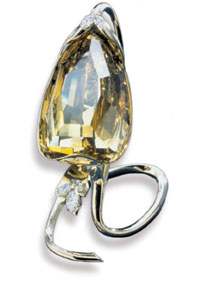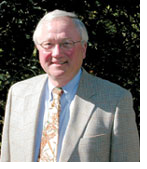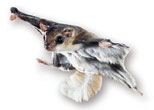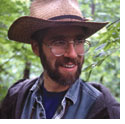
R.J. Gangewere
Among
the highlights of this year’s Gem & Mineral
Show is the world’s largest flawless diamond— all
407.48 carats of it!
 Carnegie
Museum of Natural History annually hosts one of the
world’s most outstanding shows of gems and minerals.
In 2003, the Sixth Annual Carnegie Gem & Mineral
Show will be presented by PNC Financial Services and
the world-renowned jeweler, Bailey, Banks and Biddle. Carnegie
Museum of Natural History annually hosts one of the
world’s most outstanding shows of gems and minerals.
In 2003, the Sixth Annual Carnegie Gem & Mineral
Show will be presented by PNC Financial Services and
the world-renowned jeweler, Bailey, Banks and Biddle.
More than three-dozen vendors with specimens from
famous mines and worldwide locations, as well as displays
by award-winning jewelry designers, will fill the elegant
halls of
the Oakland museums.
Diamonds are in the spotlight
this year. On special exhibit in the Founders Room
will be the 407.48-carat
Incomparable, the world’s largest internally
flawless faceted diamond. Accompanying the Incomparable will be its 14 satellite diamonds of various colors
and shapes, weighing from 1.33 to 15.66 carats.
Admission: This year the show is free with general museum
admission ($8 for adults, $5 for children
and seniors) through the generosity of the show’s
Presenting Sponsors.
Special Show Events
The Diamond Dazzler Gala
Thursday, November 20, 7-10 p.m.
A catered reception. Be the first to see the spectacular
gems and minerals from some of the world’s
most prestigious retailers. For reservations call
412.622.3232.
Benefit Mineral Auction and Awards Ceremony
Saturday, November 22, 7-10 p.m.
Awards will be given out for outstanding displays,
and an auction of stunning museum pieces de-accessioned
from the collections of Carnegie Museum of Natural
History, the Houston Museum of Natural Science,
Seaman Mineralogical Museum, and Harvard Mineralogical
Museum.
Bidding starts at 7 p.m. Public Displays and Activities
Friday, November 21, 10 a.m.-6 p.m.; Saturday,
November 22, 10 a.m.-5 p.m.(Main show), 7-10
p.m. (Awards and
Auction); Sunday, November 23, noon to 5 p.m.
See some of the most prized mineral exhibits in the
United States and Canada as invited exhibitors show
their crystals. Also, gem and mineral clubs compete
against each other for aesthetically pleasing displays,
with the winning exhibitors receiving cash prizes.
Fun for Kids with
Minerals
Bring the kids for special mineral-related activities
presented by museum educators and enthusiastic members
of local rock clubs, held in the museum classrooms.
Friday is reserved for pre-registered groups. Call
412.622.3238 for group appointments. Saturday and Sunday
are open to the public from noon to 4 p.m.
-
Pick your own geode—select a geode
from a box, have a professional crack it
open with
a machine, and
see what is inside!
-
Wire-wrap your own necklace
made up of interesting stones that
you choose.
-
Collect a set of minerals in an egg carton and
keep them. Rock club members talk to the kids about
the
properties and uses of specimens of salt, gypsum,
calcite, agate, and other rocks, and help kids
collect their
own box of specimens.
-
Pan for gems at a working sluice.

A New Director - Dr. David A. Smith
 Carnegie
Museum of Natural History has appointed Dr.
David A. Smith as the new director of Powdermill
Nature Reserve, the museum’s 2,200-acre
field station in Rector, Pennsylvania. Carnegie
Museum of Natural History has appointed Dr.
David A. Smith as the new director of Powdermill
Nature Reserve, the museum’s 2,200-acre
field station in Rector, Pennsylvania.
“We are very excited Dr. Smith has accepted
the position of director of Powdermill Nature
Reserve,” says Carnegie Museum of Natural
History Director Bill DeWalt. “He has
a wealth of financial and nonprofit management
experience. He is also well-known and respected
in the communities surrounding Powdermill,
and he holds board leadership positions in a variety of non-profit organizations.” Dr.
Smith was a founder and partner with Lane, Noland, Smith & Company Inc.,
a commercial mortgage banking company, and Pentrust Real Estate Advisory Services
Inc., a pension fund advisory business. He received his doctorate in economic
geography from the University of Pittsburgh and a Master of Arts and undergraduate
degree from Clark University, Worcester, Massachusetts.
Semi-retired since 1999,
for the past seven years Smith has served as Board chairman of Magee-Womens
Hospital, and is now chairman of Magee-Womens Health
Corporation.
He also is a board member of the University of Pittsburgh Medical Center
and Forbes Reinsurance Company Ltd.
Smith regards
Powdermill Nature Reserve as “a very
special place” and
looks forward to “helping raise the visibility and knowledge of this
outstanding resource.” He will be responsible for the day-to-day operations,
renovating and improving the facilities, encouraging regional and national
scientists to
utilize the reserve for research, increasing its endowment and building stronger
links with Carnegie Museum of Natural History and Powdermill’s community.
Science
A New Book on Mammal Species at Risk
in Pennsylvania
 Dr. Joseph Merritt, the former managing director
of Powdermill for the past 24 years, will continue
to pursue his research as resident scientist
when Dr. Smith assumes the position of director
of Powdermill. In addition to ongoing research
in the adaptations of shrews, flying squirrels,
and other small mammals to cold, Merritt has
been named co-editor by the Pennsylvania Game
Commission and Fish & Boat Commission to
update Vertebrates of Special Concern in Pennsylvania.
Merritt is also currently writing a new book,
The Biology of Small Mammals: Strategies for
Survival (The Johns Hopkins University Press). Dr. Joseph Merritt, the former managing director
of Powdermill for the past 24 years, will continue
to pursue his research as resident scientist
when Dr. Smith assumes the position of director
of Powdermill. In addition to ongoing research
in the adaptations of shrews, flying squirrels,
and other small mammals to cold, Merritt has
been named co-editor by the Pennsylvania Game
Commission and Fish & Boat Commission to
update Vertebrates of Special Concern in Pennsylvania.
Merritt is also currently writing a new book,
The Biology of Small Mammals: Strategies for
Survival (The Johns Hopkins University Press).
Vertebrates
of Special Concern in Pennsylvania was first
published in 1985, and Merritt notes
that “In the past 20 years, a lot of
energy has been given to the research, conservation,
and management of Pennsylvania’s species
of special concern. But there hasn’t
been a coordinated attempt to compile the increasing
amount of research and recommendations about
these at-risk species since the first volume
was published.”
The State Wildlife Grant
of $40,000 allows Merritt and colleague Dr.
Michael S. Steele
of Wilkes
University to update the research in a single
volume that will be both a technical reference
and a guide for management and conservation.
It will be designed to serve as a model for
the development of other similar volumes
on invertebrates
and plants. The Bird Atlas of Pennsylvania
 Robert S. Mulvihill, field ornithologist at Powdermill
Nature Reserve, has been named statewide coordinator
of Pennsylvania’s Second Breeding Bird
Atlas. The project will provide an updated
database presenting the current distribution
for about 200 nesting bird species. Robert S. Mulvihill, field ornithologist at Powdermill
Nature Reserve, has been named statewide coordinator
of Pennsylvania’s Second Breeding Bird
Atlas. The project will provide an updated
database presenting the current distribution
for about 200 nesting bird species.
Like the
first atlas, done from 1984-1989, the new version
will update statewide locations of
species of special concern, providing new information
for the management of rare species. The first
data collection is expected in January 2004.
Samples will be taken in 10-mile-square sections
statewide, with a majority of the work done in
June and July when most species are nesting.
Mulvihill has recruited regional coordinators,
and the project will involve thousands of volunteers
from the birding community. Mulvihill also
hopes to involve schools and colleges throughout
Pennsylvania. The bird atlas program was one of 15 projects
selected to share in the $2.5 million allocation
from the State Wildlife Grant Program, a cost-share
program administered through the U.S. Fish
and Wildlife Service’s federal aid
program. The five-year project is expected
to cost $366,000
and will be hosted by Carnegie Museum of Natural
History.
Back to Contents |